CPD Reference for HR Professionals: Project Management and CPD Plan
VerifiedAdded on 2023/06/14
|23
|6157
|62
Report
AI Summary
This report serves as a Continuing Professional Development (CPD) reference for HR professionals, detailing the author's personal development outcomes in compliance with CIPD demonstrations. It emphasizes individual HR responsibility in building and developing capability, aligning with the 'Thinking performer' paradigm. The report discusses the role and contribution of HR management, highlighting administrative, advisory, and executive functions, and explores the importance of HR in coordinating organizational objectives. It delves into group dynamics, examining elements at different stages such as forming and storming, and addresses team conflicts and resolution techniques. The report also covers project management techniques used by HR professionals and problem-solving methods, as well as strategies for influencing, persuading, and negotiating with others, providing a comprehensive overview of the author's professional growth and practical experiences in HR management. Desklib provides a platform for students to access solved assignments and past papers.
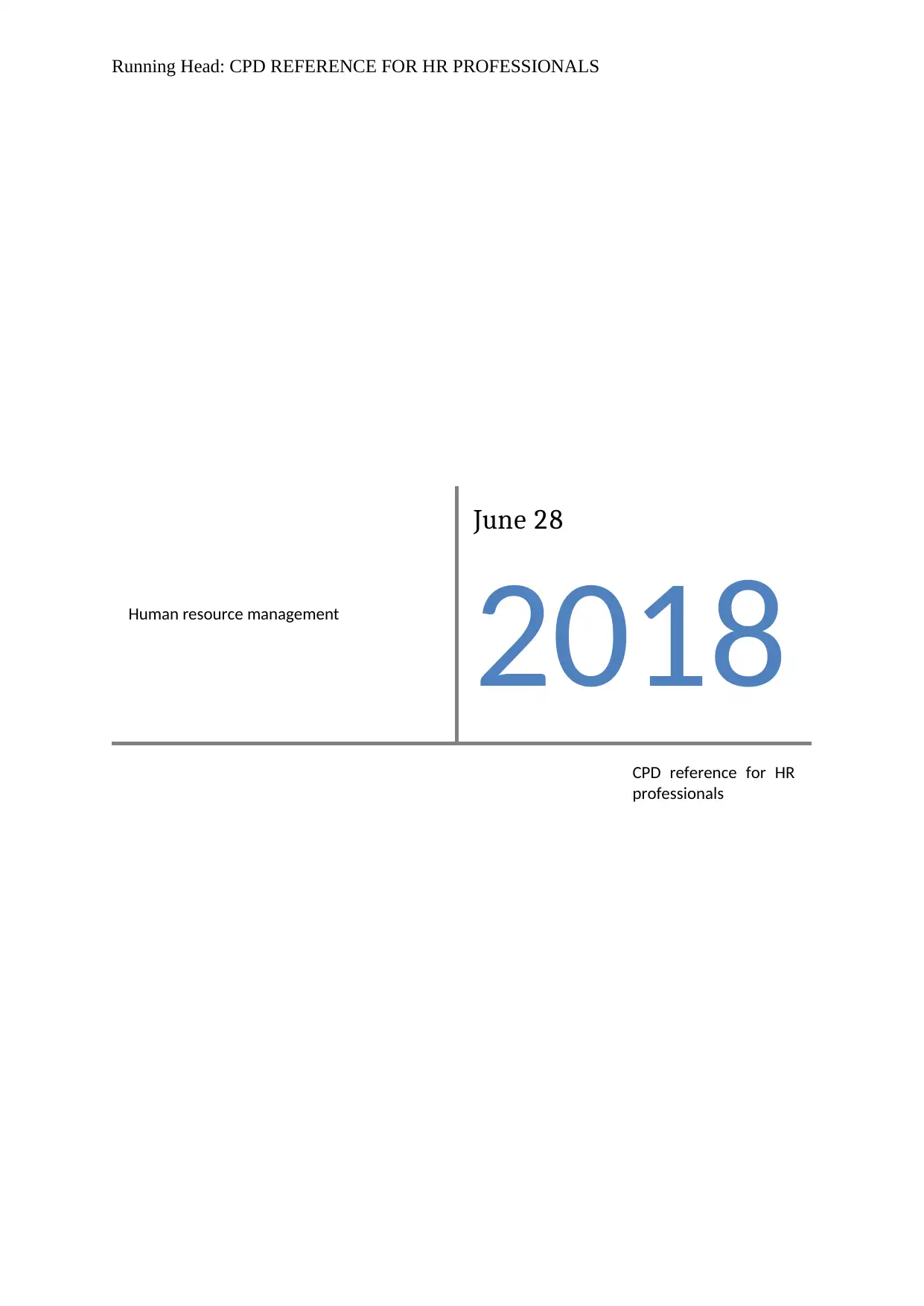
Running Head: CPD REFERENCE FOR HR PROFESSIONALS
Human resource management
June 28
2018
CPD reference for HR
professionals
Human resource management
June 28
2018
CPD reference for HR
professionals
Paraphrase This Document
Need a fresh take? Get an instant paraphrase of this document with our AI Paraphraser
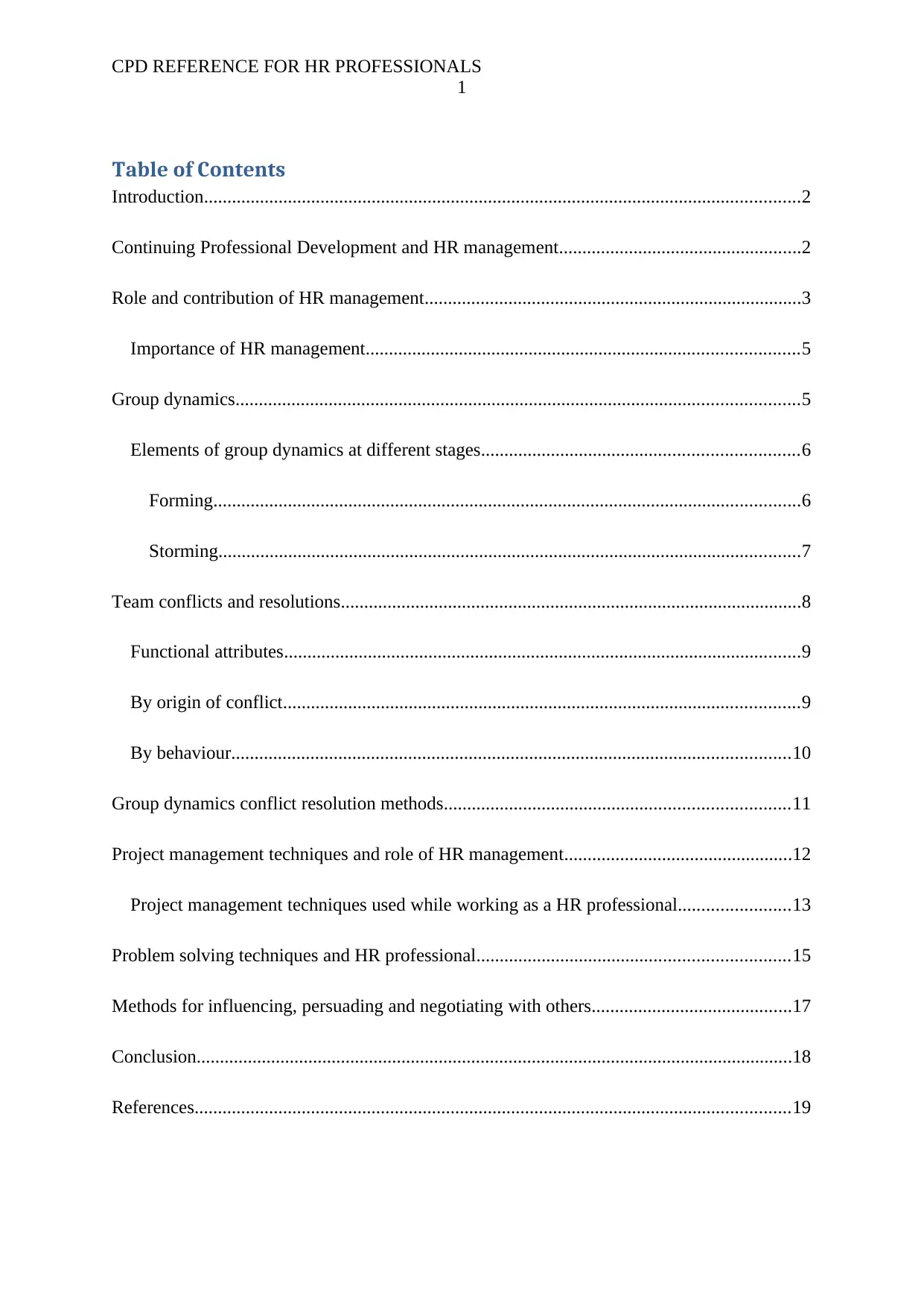
CPD REFERENCE FOR HR PROFESSIONALS
1
Table of Contents
Introduction................................................................................................................................2
Continuing Professional Development and HR management....................................................2
Role and contribution of HR management.................................................................................3
Importance of HR management.............................................................................................5
Group dynamics.........................................................................................................................5
Elements of group dynamics at different stages....................................................................6
Forming..............................................................................................................................6
Storming.............................................................................................................................7
Team conflicts and resolutions...................................................................................................8
Functional attributes...............................................................................................................9
By origin of conflict...............................................................................................................9
By behaviour........................................................................................................................10
Group dynamics conflict resolution methods..........................................................................11
Project management techniques and role of HR management.................................................12
Project management techniques used while working as a HR professional........................13
Problem solving techniques and HR professional...................................................................15
Methods for influencing, persuading and negotiating with others...........................................17
Conclusion................................................................................................................................18
References................................................................................................................................19
1
Table of Contents
Introduction................................................................................................................................2
Continuing Professional Development and HR management....................................................2
Role and contribution of HR management.................................................................................3
Importance of HR management.............................................................................................5
Group dynamics.........................................................................................................................5
Elements of group dynamics at different stages....................................................................6
Forming..............................................................................................................................6
Storming.............................................................................................................................7
Team conflicts and resolutions...................................................................................................8
Functional attributes...............................................................................................................9
By origin of conflict...............................................................................................................9
By behaviour........................................................................................................................10
Group dynamics conflict resolution methods..........................................................................11
Project management techniques and role of HR management.................................................12
Project management techniques used while working as a HR professional........................13
Problem solving techniques and HR professional...................................................................15
Methods for influencing, persuading and negotiating with others...........................................17
Conclusion................................................................................................................................18
References................................................................................................................................19
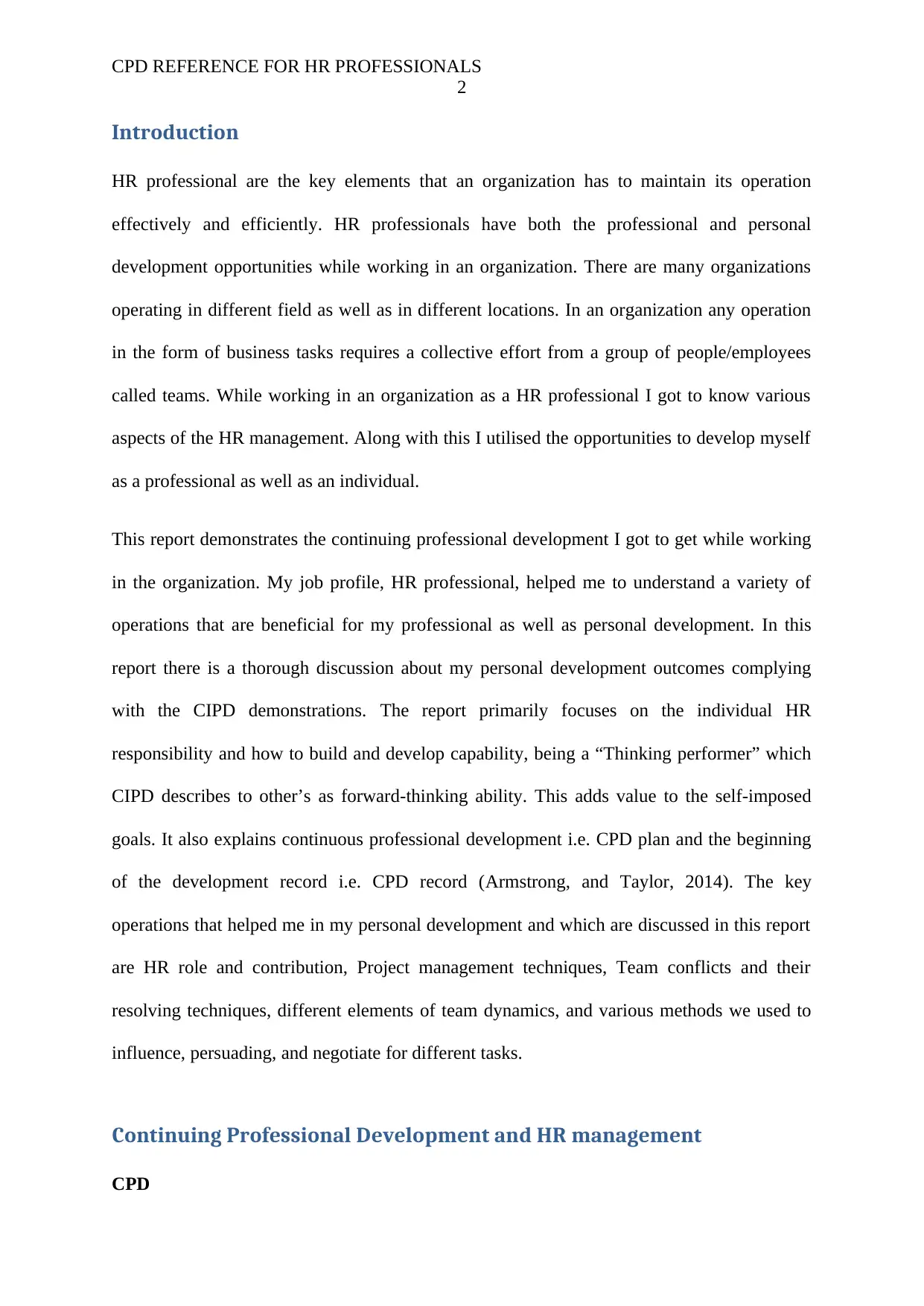
CPD REFERENCE FOR HR PROFESSIONALS
2
Introduction
HR professional are the key elements that an organization has to maintain its operation
effectively and efficiently. HR professionals have both the professional and personal
development opportunities while working in an organization. There are many organizations
operating in different field as well as in different locations. In an organization any operation
in the form of business tasks requires a collective effort from a group of people/employees
called teams. While working in an organization as a HR professional I got to know various
aspects of the HR management. Along with this I utilised the opportunities to develop myself
as a professional as well as an individual.
This report demonstrates the continuing professional development I got to get while working
in the organization. My job profile, HR professional, helped me to understand a variety of
operations that are beneficial for my professional as well as personal development. In this
report there is a thorough discussion about my personal development outcomes complying
with the CIPD demonstrations. The report primarily focuses on the individual HR
responsibility and how to build and develop capability, being a “Thinking performer” which
CIPD describes to other’s as forward-thinking ability. This adds value to the self-imposed
goals. It also explains continuous professional development i.e. CPD plan and the beginning
of the development record i.e. CPD record (Armstrong, and Taylor, 2014). The key
operations that helped me in my personal development and which are discussed in this report
are HR role and contribution, Project management techniques, Team conflicts and their
resolving techniques, different elements of team dynamics, and various methods we used to
influence, persuading, and negotiate for different tasks.
Continuing Professional Development and HR management
CPD
2
Introduction
HR professional are the key elements that an organization has to maintain its operation
effectively and efficiently. HR professionals have both the professional and personal
development opportunities while working in an organization. There are many organizations
operating in different field as well as in different locations. In an organization any operation
in the form of business tasks requires a collective effort from a group of people/employees
called teams. While working in an organization as a HR professional I got to know various
aspects of the HR management. Along with this I utilised the opportunities to develop myself
as a professional as well as an individual.
This report demonstrates the continuing professional development I got to get while working
in the organization. My job profile, HR professional, helped me to understand a variety of
operations that are beneficial for my professional as well as personal development. In this
report there is a thorough discussion about my personal development outcomes complying
with the CIPD demonstrations. The report primarily focuses on the individual HR
responsibility and how to build and develop capability, being a “Thinking performer” which
CIPD describes to other’s as forward-thinking ability. This adds value to the self-imposed
goals. It also explains continuous professional development i.e. CPD plan and the beginning
of the development record i.e. CPD record (Armstrong, and Taylor, 2014). The key
operations that helped me in my personal development and which are discussed in this report
are HR role and contribution, Project management techniques, Team conflicts and their
resolving techniques, different elements of team dynamics, and various methods we used to
influence, persuading, and negotiate for different tasks.
Continuing Professional Development and HR management
CPD
⊘ This is a preview!⊘
Do you want full access?
Subscribe today to unlock all pages.

Trusted by 1+ million students worldwide
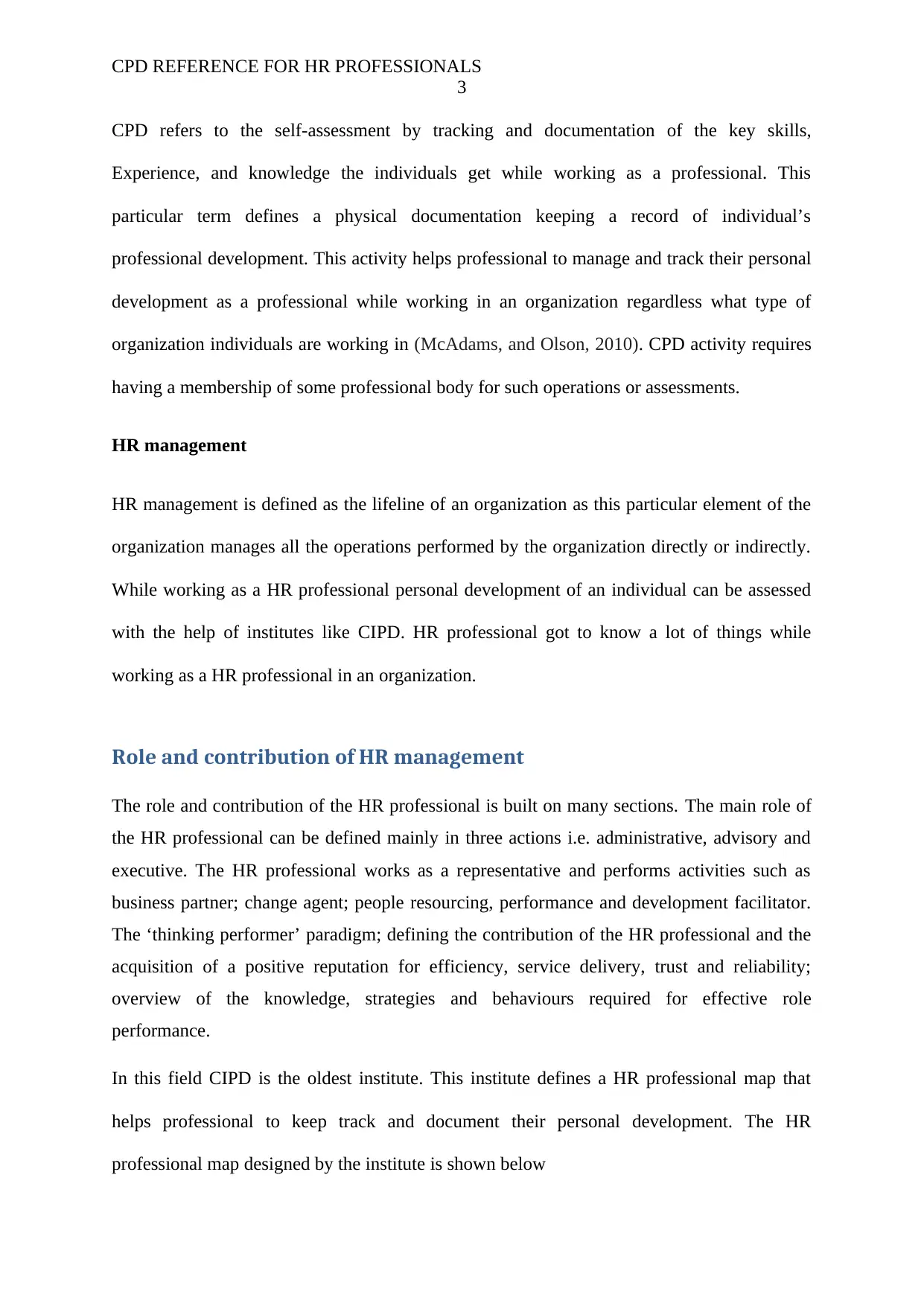
CPD REFERENCE FOR HR PROFESSIONALS
3
CPD refers to the self-assessment by tracking and documentation of the key skills,
Experience, and knowledge the individuals get while working as a professional. This
particular term defines a physical documentation keeping a record of individual’s
professional development. This activity helps professional to manage and track their personal
development as a professional while working in an organization regardless what type of
organization individuals are working in (McAdams, and Olson, 2010). CPD activity requires
having a membership of some professional body for such operations or assessments.
HR management
HR management is defined as the lifeline of an organization as this particular element of the
organization manages all the operations performed by the organization directly or indirectly.
While working as a HR professional personal development of an individual can be assessed
with the help of institutes like CIPD. HR professional got to know a lot of things while
working as a HR professional in an organization.
Role and contribution of HR management
The role and contribution of the HR professional is built on many sections. The main role of
the HR professional can be defined mainly in three actions i.e. administrative, advisory and
executive. The HR professional works as a representative and performs activities such as
business partner; change agent; people resourcing, performance and development facilitator.
The ‘thinking performer’ paradigm; defining the contribution of the HR professional and the
acquisition of a positive reputation for efficiency, service delivery, trust and reliability;
overview of the knowledge, strategies and behaviours required for effective role
performance.
In this field CIPD is the oldest institute. This institute defines a HR professional map that
helps professional to keep track and document their personal development. The HR
professional map designed by the institute is shown below
3
CPD refers to the self-assessment by tracking and documentation of the key skills,
Experience, and knowledge the individuals get while working as a professional. This
particular term defines a physical documentation keeping a record of individual’s
professional development. This activity helps professional to manage and track their personal
development as a professional while working in an organization regardless what type of
organization individuals are working in (McAdams, and Olson, 2010). CPD activity requires
having a membership of some professional body for such operations or assessments.
HR management
HR management is defined as the lifeline of an organization as this particular element of the
organization manages all the operations performed by the organization directly or indirectly.
While working as a HR professional personal development of an individual can be assessed
with the help of institutes like CIPD. HR professional got to know a lot of things while
working as a HR professional in an organization.
Role and contribution of HR management
The role and contribution of the HR professional is built on many sections. The main role of
the HR professional can be defined mainly in three actions i.e. administrative, advisory and
executive. The HR professional works as a representative and performs activities such as
business partner; change agent; people resourcing, performance and development facilitator.
The ‘thinking performer’ paradigm; defining the contribution of the HR professional and the
acquisition of a positive reputation for efficiency, service delivery, trust and reliability;
overview of the knowledge, strategies and behaviours required for effective role
performance.
In this field CIPD is the oldest institute. This institute defines a HR professional map that
helps professional to keep track and document their personal development. The HR
professional map designed by the institute is shown below
Paraphrase This Document
Need a fresh take? Get an instant paraphrase of this document with our AI Paraphraser
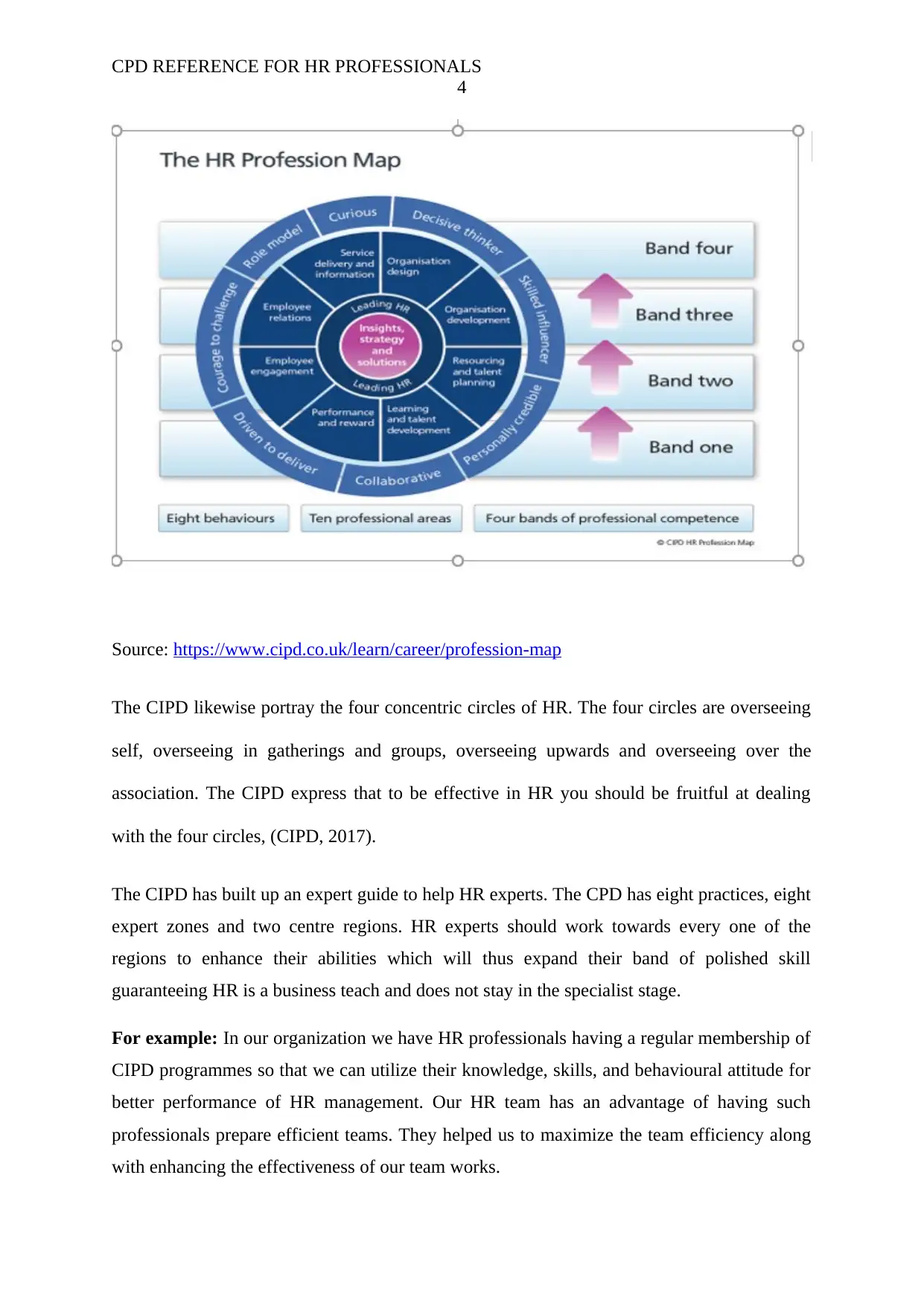
CPD REFERENCE FOR HR PROFESSIONALS
4
Source: https://www.cipd.co.uk/learn/career/profession-map
The CIPD likewise portray the four concentric circles of HR. The four circles are overseeing
self, overseeing in gatherings and groups, overseeing upwards and overseeing over the
association. The CIPD express that to be effective in HR you should be fruitful at dealing
with the four circles, (CIPD, 2017).
The CIPD has built up an expert guide to help HR experts. The CPD has eight practices, eight
expert zones and two centre regions. HR experts should work towards every one of the
regions to enhance their abilities which will thus expand their band of polished skill
guaranteeing HR is a business teach and does not stay in the specialist stage.
For example: In our organization we have HR professionals having a regular membership of
CIPD programmes so that we can utilize their knowledge, skills, and behavioural attitude for
better performance of HR management. Our HR team has an advantage of having such
professionals prepare efficient teams. They helped us to maximize the team efficiency along
with enhancing the effectiveness of our team works.
4
Source: https://www.cipd.co.uk/learn/career/profession-map
The CIPD likewise portray the four concentric circles of HR. The four circles are overseeing
self, overseeing in gatherings and groups, overseeing upwards and overseeing over the
association. The CIPD express that to be effective in HR you should be fruitful at dealing
with the four circles, (CIPD, 2017).
The CIPD has built up an expert guide to help HR experts. The CPD has eight practices, eight
expert zones and two centre regions. HR experts should work towards every one of the
regions to enhance their abilities which will thus expand their band of polished skill
guaranteeing HR is a business teach and does not stay in the specialist stage.
For example: In our organization we have HR professionals having a regular membership of
CIPD programmes so that we can utilize their knowledge, skills, and behavioural attitude for
better performance of HR management. Our HR team has an advantage of having such
professionals prepare efficient teams. They helped us to maximize the team efficiency along
with enhancing the effectiveness of our team works.
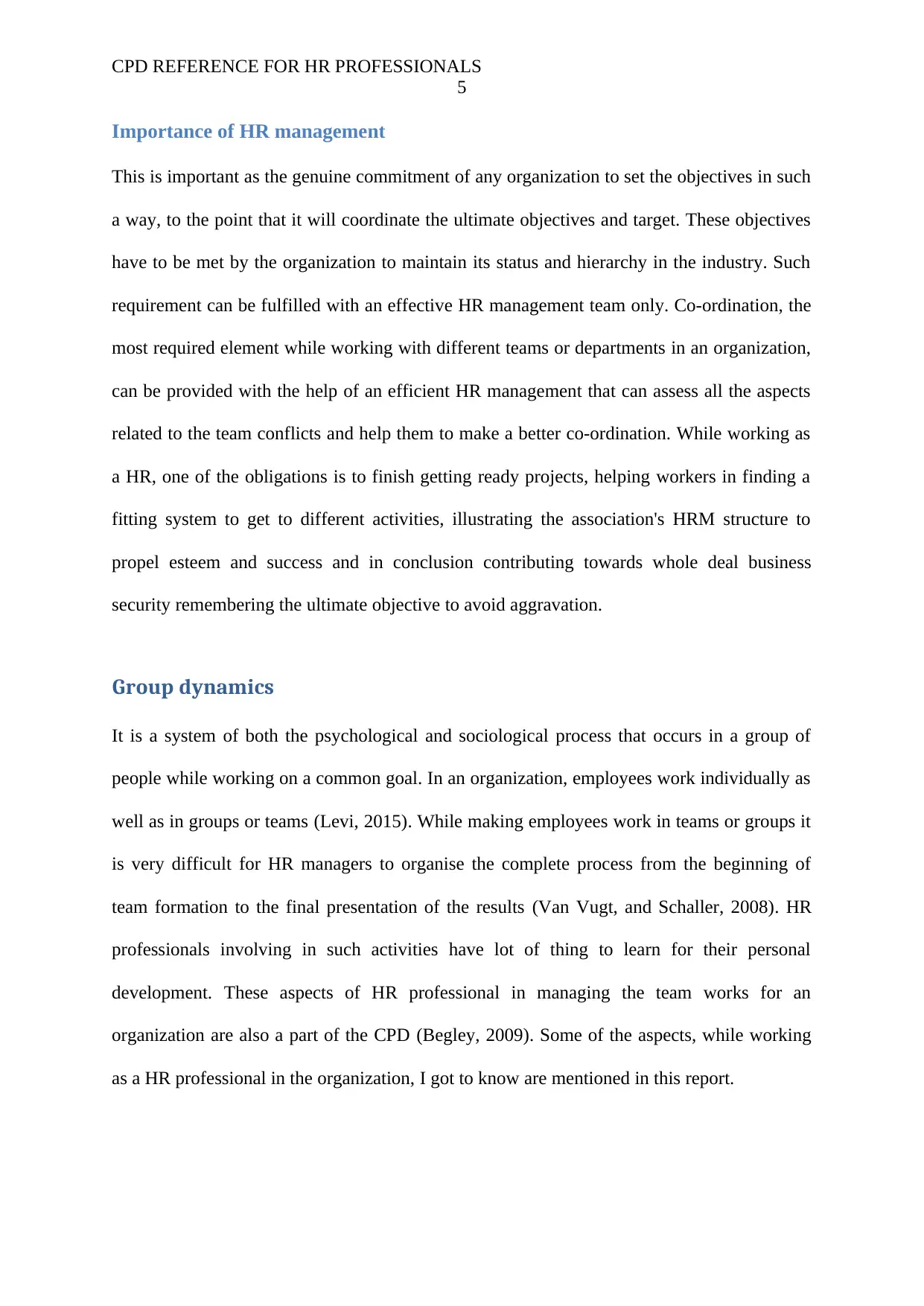
CPD REFERENCE FOR HR PROFESSIONALS
5
Importance of HR management
This is important as the genuine commitment of any organization to set the objectives in such
a way, to the point that it will coordinate the ultimate objectives and target. These objectives
have to be met by the organization to maintain its status and hierarchy in the industry. Such
requirement can be fulfilled with an effective HR management team only. Co-ordination, the
most required element while working with different teams or departments in an organization,
can be provided with the help of an efficient HR management that can assess all the aspects
related to the team conflicts and help them to make a better co-ordination. While working as
a HR, one of the obligations is to finish getting ready projects, helping workers in finding a
fitting system to get to different activities, illustrating the association's HRM structure to
propel esteem and success and in conclusion contributing towards whole deal business
security remembering the ultimate objective to avoid aggravation.
Group dynamics
It is a system of both the psychological and sociological process that occurs in a group of
people while working on a common goal. In an organization, employees work individually as
well as in groups or teams (Levi, 2015). While making employees work in teams or groups it
is very difficult for HR managers to organise the complete process from the beginning of
team formation to the final presentation of the results (Van Vugt, and Schaller, 2008). HR
professionals involving in such activities have lot of thing to learn for their personal
development. These aspects of HR professional in managing the team works for an
organization are also a part of the CPD (Begley, 2009). Some of the aspects, while working
as a HR professional in the organization, I got to know are mentioned in this report.
5
Importance of HR management
This is important as the genuine commitment of any organization to set the objectives in such
a way, to the point that it will coordinate the ultimate objectives and target. These objectives
have to be met by the organization to maintain its status and hierarchy in the industry. Such
requirement can be fulfilled with an effective HR management team only. Co-ordination, the
most required element while working with different teams or departments in an organization,
can be provided with the help of an efficient HR management that can assess all the aspects
related to the team conflicts and help them to make a better co-ordination. While working as
a HR, one of the obligations is to finish getting ready projects, helping workers in finding a
fitting system to get to different activities, illustrating the association's HRM structure to
propel esteem and success and in conclusion contributing towards whole deal business
security remembering the ultimate objective to avoid aggravation.
Group dynamics
It is a system of both the psychological and sociological process that occurs in a group of
people while working on a common goal. In an organization, employees work individually as
well as in groups or teams (Levi, 2015). While making employees work in teams or groups it
is very difficult for HR managers to organise the complete process from the beginning of
team formation to the final presentation of the results (Van Vugt, and Schaller, 2008). HR
professionals involving in such activities have lot of thing to learn for their personal
development. These aspects of HR professional in managing the team works for an
organization are also a part of the CPD (Begley, 2009). Some of the aspects, while working
as a HR professional in the organization, I got to know are mentioned in this report.
⊘ This is a preview!⊘
Do you want full access?
Subscribe today to unlock all pages.

Trusted by 1+ million students worldwide
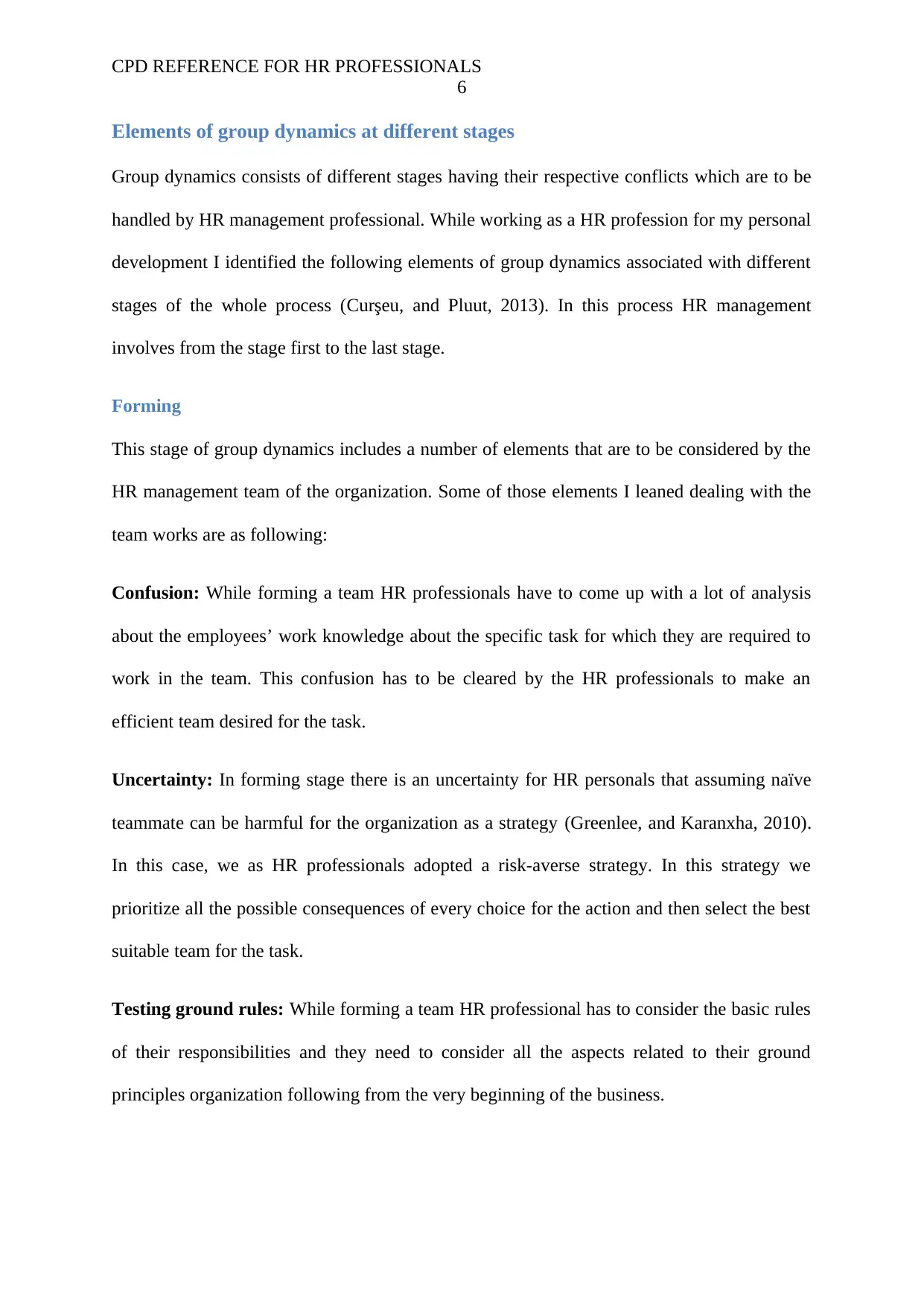
CPD REFERENCE FOR HR PROFESSIONALS
6
Elements of group dynamics at different stages
Group dynamics consists of different stages having their respective conflicts which are to be
handled by HR management professional. While working as a HR profession for my personal
development I identified the following elements of group dynamics associated with different
stages of the whole process (Curşeu, and Pluut, 2013). In this process HR management
involves from the stage first to the last stage.
Forming
This stage of group dynamics includes a number of elements that are to be considered by the
HR management team of the organization. Some of those elements I leaned dealing with the
team works are as following:
Confusion: While forming a team HR professionals have to come up with a lot of analysis
about the employees’ work knowledge about the specific task for which they are required to
work in the team. This confusion has to be cleared by the HR professionals to make an
efficient team desired for the task.
Uncertainty: In forming stage there is an uncertainty for HR personals that assuming naïve
teammate can be harmful for the organization as a strategy (Greenlee, and Karanxha, 2010).
In this case, we as HR professionals adopted a risk-averse strategy. In this strategy we
prioritize all the possible consequences of every choice for the action and then select the best
suitable team for the task.
Testing ground rules: While forming a team HR professional has to consider the basic rules
of their responsibilities and they need to consider all the aspects related to their ground
principles organization following from the very beginning of the business.
6
Elements of group dynamics at different stages
Group dynamics consists of different stages having their respective conflicts which are to be
handled by HR management professional. While working as a HR profession for my personal
development I identified the following elements of group dynamics associated with different
stages of the whole process (Curşeu, and Pluut, 2013). In this process HR management
involves from the stage first to the last stage.
Forming
This stage of group dynamics includes a number of elements that are to be considered by the
HR management team of the organization. Some of those elements I leaned dealing with the
team works are as following:
Confusion: While forming a team HR professionals have to come up with a lot of analysis
about the employees’ work knowledge about the specific task for which they are required to
work in the team. This confusion has to be cleared by the HR professionals to make an
efficient team desired for the task.
Uncertainty: In forming stage there is an uncertainty for HR personals that assuming naïve
teammate can be harmful for the organization as a strategy (Greenlee, and Karanxha, 2010).
In this case, we as HR professionals adopted a risk-averse strategy. In this strategy we
prioritize all the possible consequences of every choice for the action and then select the best
suitable team for the task.
Testing ground rules: While forming a team HR professional has to consider the basic rules
of their responsibilities and they need to consider all the aspects related to their ground
principles organization following from the very beginning of the business.
Paraphrase This Document
Need a fresh take? Get an instant paraphrase of this document with our AI Paraphraser
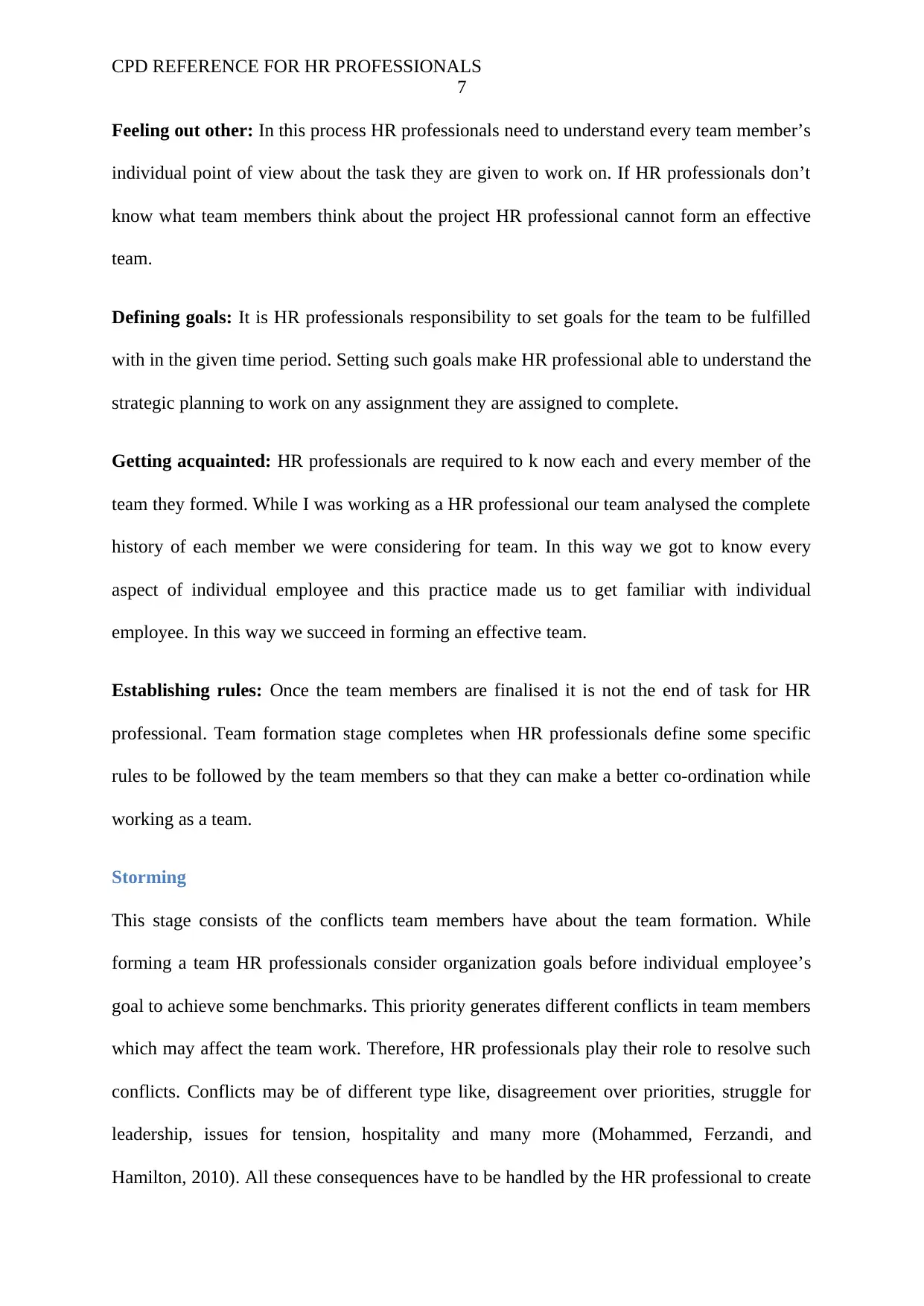
CPD REFERENCE FOR HR PROFESSIONALS
7
Feeling out other: In this process HR professionals need to understand every team member’s
individual point of view about the task they are given to work on. If HR professionals don’t
know what team members think about the project HR professional cannot form an effective
team.
Defining goals: It is HR professionals responsibility to set goals for the team to be fulfilled
with in the given time period. Setting such goals make HR professional able to understand the
strategic planning to work on any assignment they are assigned to complete.
Getting acquainted: HR professionals are required to k now each and every member of the
team they formed. While I was working as a HR professional our team analysed the complete
history of each member we were considering for team. In this way we got to know every
aspect of individual employee and this practice made us to get familiar with individual
employee. In this way we succeed in forming an effective team.
Establishing rules: Once the team members are finalised it is not the end of task for HR
professional. Team formation stage completes when HR professionals define some specific
rules to be followed by the team members so that they can make a better co-ordination while
working as a team.
Storming
This stage consists of the conflicts team members have about the team formation. While
forming a team HR professionals consider organization goals before individual employee’s
goal to achieve some benchmarks. This priority generates different conflicts in team members
which may affect the team work. Therefore, HR professionals play their role to resolve such
conflicts. Conflicts may be of different type like, disagreement over priorities, struggle for
leadership, issues for tension, hospitality and many more (Mohammed, Ferzandi, and
Hamilton, 2010). All these consequences have to be handled by the HR professional to create
7
Feeling out other: In this process HR professionals need to understand every team member’s
individual point of view about the task they are given to work on. If HR professionals don’t
know what team members think about the project HR professional cannot form an effective
team.
Defining goals: It is HR professionals responsibility to set goals for the team to be fulfilled
with in the given time period. Setting such goals make HR professional able to understand the
strategic planning to work on any assignment they are assigned to complete.
Getting acquainted: HR professionals are required to k now each and every member of the
team they formed. While I was working as a HR professional our team analysed the complete
history of each member we were considering for team. In this way we got to know every
aspect of individual employee and this practice made us to get familiar with individual
employee. In this way we succeed in forming an effective team.
Establishing rules: Once the team members are finalised it is not the end of task for HR
professional. Team formation stage completes when HR professionals define some specific
rules to be followed by the team members so that they can make a better co-ordination while
working as a team.
Storming
This stage consists of the conflicts team members have about the team formation. While
forming a team HR professionals consider organization goals before individual employee’s
goal to achieve some benchmarks. This priority generates different conflicts in team members
which may affect the team work. Therefore, HR professionals play their role to resolve such
conflicts. Conflicts may be of different type like, disagreement over priorities, struggle for
leadership, issues for tension, hospitality and many more (Mohammed, Ferzandi, and
Hamilton, 2010). All these consequences have to be handled by the HR professional to create
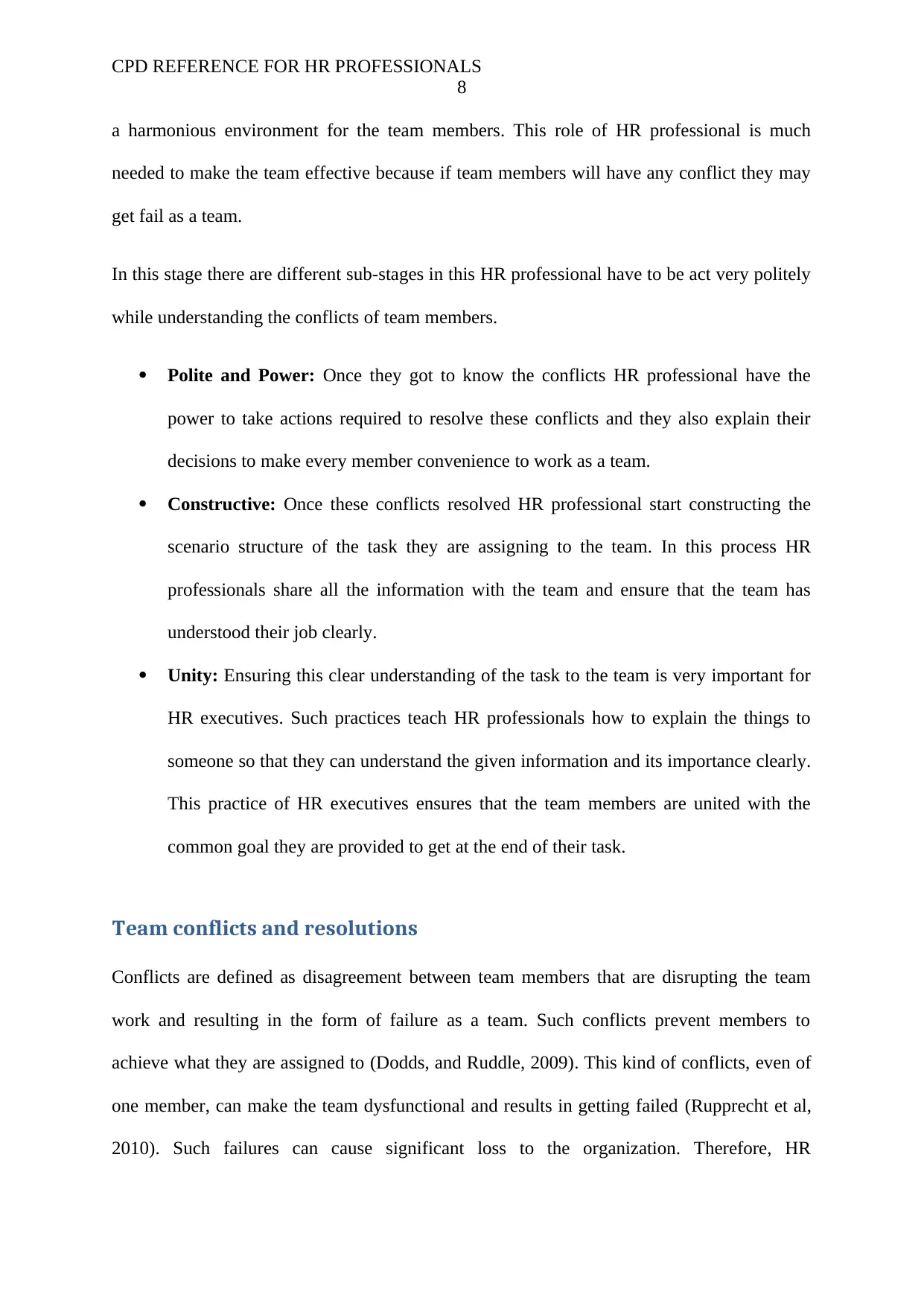
CPD REFERENCE FOR HR PROFESSIONALS
8
a harmonious environment for the team members. This role of HR professional is much
needed to make the team effective because if team members will have any conflict they may
get fail as a team.
In this stage there are different sub-stages in this HR professional have to be act very politely
while understanding the conflicts of team members.
Polite and Power: Once they got to know the conflicts HR professional have the
power to take actions required to resolve these conflicts and they also explain their
decisions to make every member convenience to work as a team.
Constructive: Once these conflicts resolved HR professional start constructing the
scenario structure of the task they are assigning to the team. In this process HR
professionals share all the information with the team and ensure that the team has
understood their job clearly.
Unity: Ensuring this clear understanding of the task to the team is very important for
HR executives. Such practices teach HR professionals how to explain the things to
someone so that they can understand the given information and its importance clearly.
This practice of HR executives ensures that the team members are united with the
common goal they are provided to get at the end of their task.
Team conflicts and resolutions
Conflicts are defined as disagreement between team members that are disrupting the team
work and resulting in the form of failure as a team. Such conflicts prevent members to
achieve what they are assigned to (Dodds, and Ruddle, 2009). This kind of conflicts, even of
one member, can make the team dysfunctional and results in getting failed (Rupprecht et al,
2010). Such failures can cause significant loss to the organization. Therefore, HR
8
a harmonious environment for the team members. This role of HR professional is much
needed to make the team effective because if team members will have any conflict they may
get fail as a team.
In this stage there are different sub-stages in this HR professional have to be act very politely
while understanding the conflicts of team members.
Polite and Power: Once they got to know the conflicts HR professional have the
power to take actions required to resolve these conflicts and they also explain their
decisions to make every member convenience to work as a team.
Constructive: Once these conflicts resolved HR professional start constructing the
scenario structure of the task they are assigning to the team. In this process HR
professionals share all the information with the team and ensure that the team has
understood their job clearly.
Unity: Ensuring this clear understanding of the task to the team is very important for
HR executives. Such practices teach HR professionals how to explain the things to
someone so that they can understand the given information and its importance clearly.
This practice of HR executives ensures that the team members are united with the
common goal they are provided to get at the end of their task.
Team conflicts and resolutions
Conflicts are defined as disagreement between team members that are disrupting the team
work and resulting in the form of failure as a team. Such conflicts prevent members to
achieve what they are assigned to (Dodds, and Ruddle, 2009). This kind of conflicts, even of
one member, can make the team dysfunctional and results in getting failed (Rupprecht et al,
2010). Such failures can cause significant loss to the organization. Therefore, HR
⊘ This is a preview!⊘
Do you want full access?
Subscribe today to unlock all pages.

Trusted by 1+ million students worldwide
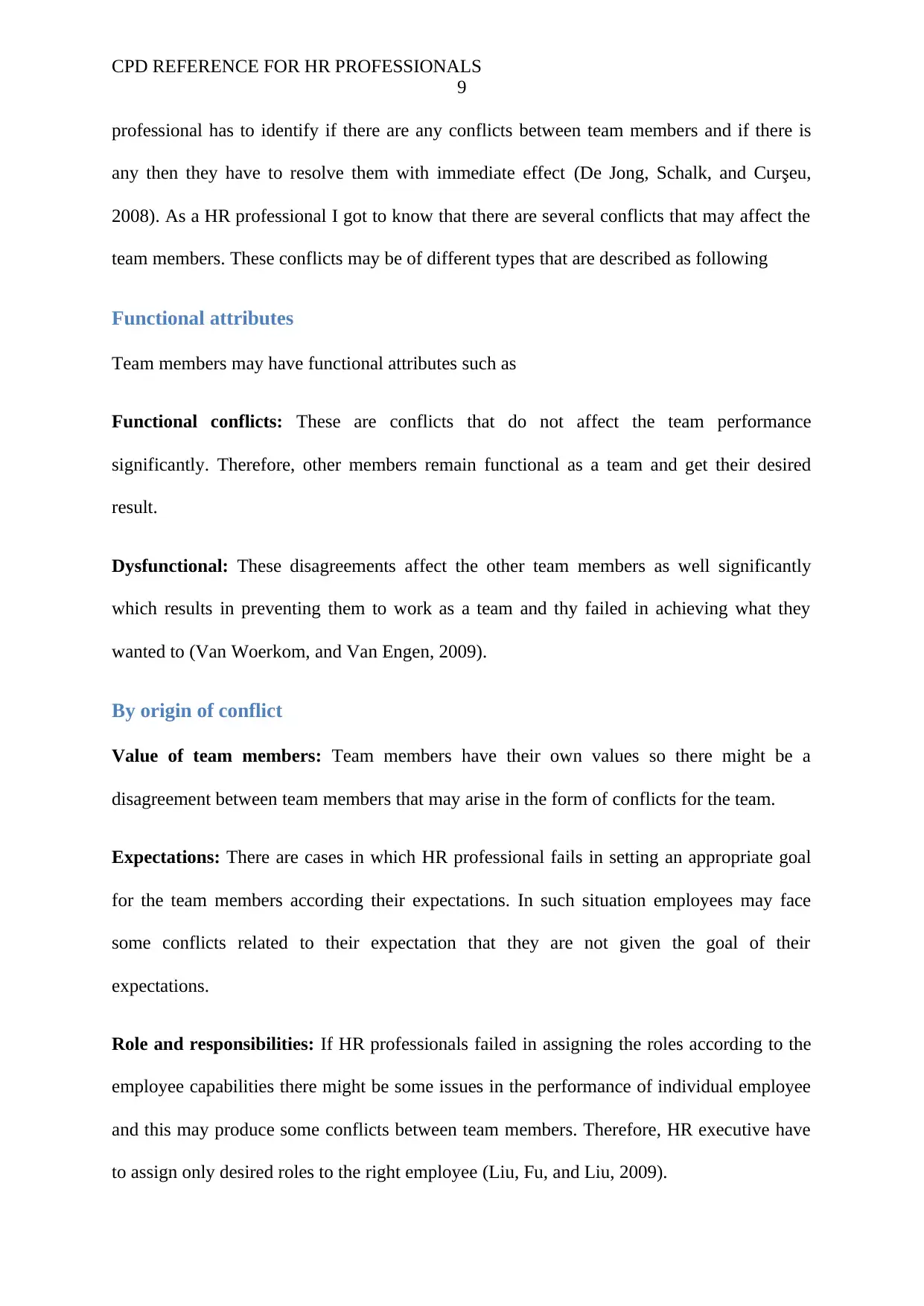
CPD REFERENCE FOR HR PROFESSIONALS
9
professional has to identify if there are any conflicts between team members and if there is
any then they have to resolve them with immediate effect (De Jong, Schalk, and Curşeu,
2008). As a HR professional I got to know that there are several conflicts that may affect the
team members. These conflicts may be of different types that are described as following
Functional attributes
Team members may have functional attributes such as
Functional conflicts: These are conflicts that do not affect the team performance
significantly. Therefore, other members remain functional as a team and get their desired
result.
Dysfunctional: These disagreements affect the other team members as well significantly
which results in preventing them to work as a team and thy failed in achieving what they
wanted to (Van Woerkom, and Van Engen, 2009).
By origin of conflict
Value of team members: Team members have their own values so there might be a
disagreement between team members that may arise in the form of conflicts for the team.
Expectations: There are cases in which HR professional fails in setting an appropriate goal
for the team members according their expectations. In such situation employees may face
some conflicts related to their expectation that they are not given the goal of their
expectations.
Role and responsibilities: If HR professionals failed in assigning the roles according to the
employee capabilities there might be some issues in the performance of individual employee
and this may produce some conflicts between team members. Therefore, HR executive have
to assign only desired roles to the right employee (Liu, Fu, and Liu, 2009).
9
professional has to identify if there are any conflicts between team members and if there is
any then they have to resolve them with immediate effect (De Jong, Schalk, and Curşeu,
2008). As a HR professional I got to know that there are several conflicts that may affect the
team members. These conflicts may be of different types that are described as following
Functional attributes
Team members may have functional attributes such as
Functional conflicts: These are conflicts that do not affect the team performance
significantly. Therefore, other members remain functional as a team and get their desired
result.
Dysfunctional: These disagreements affect the other team members as well significantly
which results in preventing them to work as a team and thy failed in achieving what they
wanted to (Van Woerkom, and Van Engen, 2009).
By origin of conflict
Value of team members: Team members have their own values so there might be a
disagreement between team members that may arise in the form of conflicts for the team.
Expectations: There are cases in which HR professional fails in setting an appropriate goal
for the team members according their expectations. In such situation employees may face
some conflicts related to their expectation that they are not given the goal of their
expectations.
Role and responsibilities: If HR professionals failed in assigning the roles according to the
employee capabilities there might be some issues in the performance of individual employee
and this may produce some conflicts between team members. Therefore, HR executive have
to assign only desired roles to the right employee (Liu, Fu, and Liu, 2009).
Paraphrase This Document
Need a fresh take? Get an instant paraphrase of this document with our AI Paraphraser
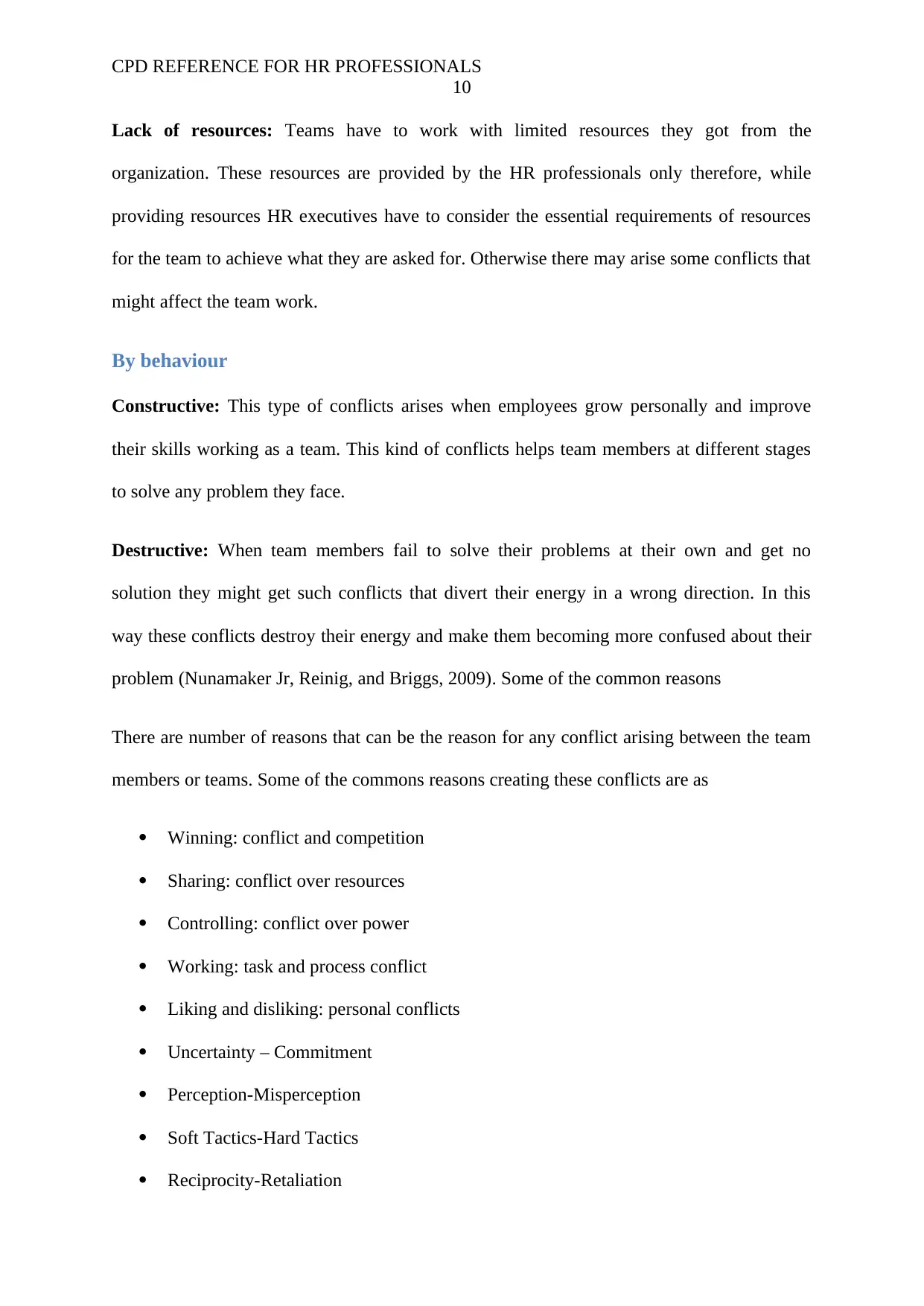
CPD REFERENCE FOR HR PROFESSIONALS
10
Lack of resources: Teams have to work with limited resources they got from the
organization. These resources are provided by the HR professionals only therefore, while
providing resources HR executives have to consider the essential requirements of resources
for the team to achieve what they are asked for. Otherwise there may arise some conflicts that
might affect the team work.
By behaviour
Constructive: This type of conflicts arises when employees grow personally and improve
their skills working as a team. This kind of conflicts helps team members at different stages
to solve any problem they face.
Destructive: When team members fail to solve their problems at their own and get no
solution they might get such conflicts that divert their energy in a wrong direction. In this
way these conflicts destroy their energy and make them becoming more confused about their
problem (Nunamaker Jr, Reinig, and Briggs, 2009). Some of the common reasons
There are number of reasons that can be the reason for any conflict arising between the team
members or teams. Some of the commons reasons creating these conflicts are as
Winning: conflict and competition
Sharing: conflict over resources
Controlling: conflict over power
Working: task and process conflict
Liking and disliking: personal conflicts
Uncertainty – Commitment
Perception-Misperception
Soft Tactics-Hard Tactics
Reciprocity-Retaliation
10
Lack of resources: Teams have to work with limited resources they got from the
organization. These resources are provided by the HR professionals only therefore, while
providing resources HR executives have to consider the essential requirements of resources
for the team to achieve what they are asked for. Otherwise there may arise some conflicts that
might affect the team work.
By behaviour
Constructive: This type of conflicts arises when employees grow personally and improve
their skills working as a team. This kind of conflicts helps team members at different stages
to solve any problem they face.
Destructive: When team members fail to solve their problems at their own and get no
solution they might get such conflicts that divert their energy in a wrong direction. In this
way these conflicts destroy their energy and make them becoming more confused about their
problem (Nunamaker Jr, Reinig, and Briggs, 2009). Some of the common reasons
There are number of reasons that can be the reason for any conflict arising between the team
members or teams. Some of the commons reasons creating these conflicts are as
Winning: conflict and competition
Sharing: conflict over resources
Controlling: conflict over power
Working: task and process conflict
Liking and disliking: personal conflicts
Uncertainty – Commitment
Perception-Misperception
Soft Tactics-Hard Tactics
Reciprocity-Retaliation
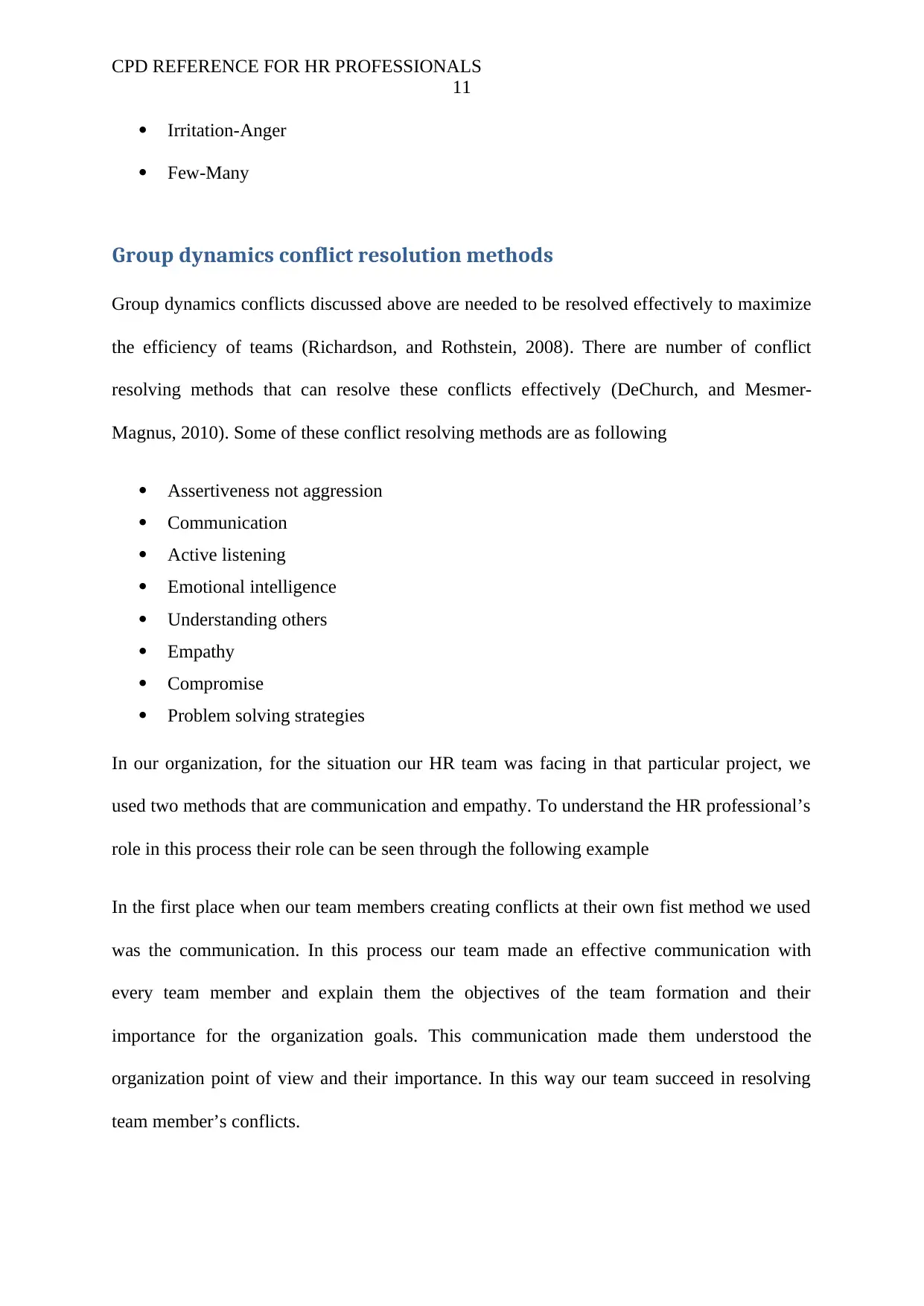
CPD REFERENCE FOR HR PROFESSIONALS
11
Irritation-Anger
Few-Many
Group dynamics conflict resolution methods
Group dynamics conflicts discussed above are needed to be resolved effectively to maximize
the efficiency of teams (Richardson, and Rothstein, 2008). There are number of conflict
resolving methods that can resolve these conflicts effectively (DeChurch, and Mesmer-
Magnus, 2010). Some of these conflict resolving methods are as following
Assertiveness not aggression
Communication
Active listening
Emotional intelligence
Understanding others
Empathy
Compromise
Problem solving strategies
In our organization, for the situation our HR team was facing in that particular project, we
used two methods that are communication and empathy. To understand the HR professional’s
role in this process their role can be seen through the following example
In the first place when our team members creating conflicts at their own fist method we used
was the communication. In this process our team made an effective communication with
every team member and explain them the objectives of the team formation and their
importance for the organization goals. This communication made them understood the
organization point of view and their importance. In this way our team succeed in resolving
team member’s conflicts.
11
Irritation-Anger
Few-Many
Group dynamics conflict resolution methods
Group dynamics conflicts discussed above are needed to be resolved effectively to maximize
the efficiency of teams (Richardson, and Rothstein, 2008). There are number of conflict
resolving methods that can resolve these conflicts effectively (DeChurch, and Mesmer-
Magnus, 2010). Some of these conflict resolving methods are as following
Assertiveness not aggression
Communication
Active listening
Emotional intelligence
Understanding others
Empathy
Compromise
Problem solving strategies
In our organization, for the situation our HR team was facing in that particular project, we
used two methods that are communication and empathy. To understand the HR professional’s
role in this process their role can be seen through the following example
In the first place when our team members creating conflicts at their own fist method we used
was the communication. In this process our team made an effective communication with
every team member and explain them the objectives of the team formation and their
importance for the organization goals. This communication made them understood the
organization point of view and their importance. In this way our team succeed in resolving
team member’s conflicts.
⊘ This is a preview!⊘
Do you want full access?
Subscribe today to unlock all pages.

Trusted by 1+ million students worldwide
1 out of 23
Related Documents
Your All-in-One AI-Powered Toolkit for Academic Success.
+13062052269
info@desklib.com
Available 24*7 on WhatsApp / Email
![[object Object]](/_next/static/media/star-bottom.7253800d.svg)
Unlock your academic potential
Copyright © 2020–2025 A2Z Services. All Rights Reserved. Developed and managed by ZUCOL.


![5DVP: Developing Professional Practice Report - [University Name]](/_next/image/?url=https%3A%2F%2Fdesklib.com%2Fmedia%2Fimages%2Frq%2Fd1f1fed29d4c4b72b622be5f5f3b52cf.jpg&w=256&q=75)


